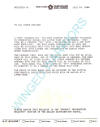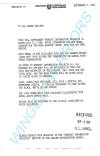


WINGED WARRIORS/NATIONAL B-BODY OWNERS ASSOCIATION
DAYTONA AND SUPERBIRD DEVELOPMENT FACTORY DOCUMENTS
FROM THE COLLECTION OF SUE GEORGE
WITH THANKS TO ROGER GIBSON, DAVE BENASUTTI, ROGER WILSON, DAVID PATIK, and DICK PADOVINI
On this page, you'll see a collection of factory documents dealing with the design, development, testing and production of the 1969 Daytona and 1970 Superbird. Some of these documents have never been seen before, except by the members of Winged Warriors/NBOA club.
Anyone who appreciates winged cars should get a kick out of this first document, below left, dated September 22, 1967. It deals with the name "Daytona", and the fact that Chrysler's Public Relations Director Frank Wylie wanted to use it on one of the 1968 Dodge Dart models. And yes, in retrospect, it would have been horrendous if GM had acquired ownership of the name! The document below right announced the forthcoming of the 1969 Charger 500 as a special model. Note that early-on Chrysler intended to build only Hemi Charger 500s. By the time production actually began, a 440 4bbl was also available, as noted in Bulletin #4 below dated September 9, 1968.
The first three documents below deal with engine temperature issues encountered during testing of the Daytona. At first glance they look alike, but they are not. They deal with temperature testing of different versions of the Daytona. The next two documents confirm the dates that Chrysler plans to test the Daytona at the Chrysler proving grounds with NASCAR racers Buddy Baker and Charlie Glotzbach driving. I've also included two pages of notes from Gary Romberg's (Chrysler aerodynamicist) black notebook. The first one refers to the July 12 and 13, 1969 day of testing at the Proving Grounds. The crude sketch at the center right on that document is the Daytona's nosecone spoiler and you can see the different configurations they tried those days. Note: CL means "lift coefficient". The document next to that is from August 6 and August 8, 1969. This document deals with testing the Daytona's front spoiler and grille opening area, water temperature and interestingly a hood scoop that was tried and failed. NOTE: These documents have been typed for ease of reading (the originals are handwritten scribbles) but all content is guaranteed to be exactly as it appears. Sketches are scanned from originals and inserted into the text.
Below from left to right: (1) A 3-page inter-company memo explaining the performance, handling and air flow of the Daytona's aerodynamics; (2) a memo dealing with downforce on the nosecone and spoiler location on the Daytona; (3) next is the shipping invoice showing that the Wichita State University received the Daytona 3/8 scale model, extra clay for molding parts on, and two versions of nosecones for testing in their wind tunnel. Note the date of this document is February 1970, and this is the "G Series" car, so this is the 1971 model they were designing and testing. After Chrysler spent much money to get this car to the production stage, it was never actually built. Chrysler dropped out of racing that year and the winged car project was scrapped.
Shown below is a document outlining aerodynamic results of testing the 3/8 scale model, in 1969 Daytona configuration, in the wind tunnel, and the three diagram/graphs explaining the data.
This next document below compares aerodynamic qualities of the "E" series race car (very early configuration) to the "F" series (later nosecone, stabilizers and spoiler on the Daytona) race cars and its accompanying illustrations. Below those documents are six pages of Larry Rathgeb's formulas and sketches made during testing of the various stabilizers (wings).
The next document below shows Plymouth's many indecisions about even producing the Superbird. By the time they decided to go ahead with the program, it was late August 1969 and 1,935 Superbirds had to be built between October 17 and the end of the year--an extremely rushed production! We've been told that half-way through the time frame, production was so far behind that Chrysler offered the assembly line workers 50¢ extra per hour as an incentive to get more cars done each day.
Above, in the second row of documents, is the inter-company memo outlining the production time-frames and procedures that would be used to build the 1970 Superbirds. Note that early on the effort was called "Plymouth-Belvedere NASCAR Program". Mr. A. J. Fleming was on the Production Engineering Team at Hamtramck Assembly Plant in Hamtramck, MI at the time. Ironically, this document states that the lacquered nosecones must match the body color. None of them did! The spoilers were also painted body color, not argent as was directed on this memo. Below that are the three pages of tooling and fixtures that Chrysler would require Creative Industries to build or acquire for production of the Superbird
Above is Chrysler's check list of modifications that had to be made to the Belvederes to convert them to Superbirds. Below is a three-page study of aerodynamic testing done on the Superbird with and without windows and with a "Petty" NASCAR spoiler. Below that are four pages of graphs and data of the results of testing the Superbird. Ever wonder how Chrysler came up with that unusual honeycomb design for the Superbird grille screen? The fifth document below is a very interesting piece of history showing how this screen material was designed by Gary Romberg. The exact shape and size of each opening in the screen was crucial to the Superbird's cooling.
Below are notes and sketches from Chrysler Aerodynamicist Gary Romberg's little black book. The text has been typed so you can read it, but the contents are exactly as it originally appears in his book. These notes concern the days that the engineers took the Daytona racecar and it's various nosecones, cold air ducting, and front spoilers to Daytona Speedway to run tests. They also did a lot of testing on the angle of the wing's horizontal bar.
CHRYSLER ASSEMBLY LINE INSPECTION DOCUMENTS
Shown here is a collection of assembly line inspection sheets and repair orders. From left to right: These first two documents are a mechanic's inspection sheets from the Hamtramck Assembly Plant. It lists all the mechanical and safety items on the car that the assembly line inspector had to look at. Note that "shy" is one of the choices the inspector could use to describe a rejected item on a car. The inspection was quite thorough and anything that was rejected required the car to be pulled off the assembly line and placed in the repair hole to be repaired. These sheets were thrown inside the car, usually on the floor, by the assembly line worker when the repair was done, and eventually covered up with the carpet. The next two documents show the front and back side of a different inspection sheet, this one used by the Final Line at the Lynch Road Assembly Plant. You can see the inspector's punches at the bottom of the sheet. This inspection sheet was found on the floor of a 1970 Plymouth.
Shown below are repair order sheets used on the assembly line when a problem is found on a car. The first document is from the Paint Department at the Lynch Road Assembly Plant. This repair order tells quite a bit about the situation. This car was special order number 039417 and had a marred finish and a ding on the front area of the roof that needed to be repaired and also some kind of a problem with the solder joint at the roof-quarter. Repair man #31 on the third shift was assigned to do the repair. This car was F8 dark green with an F8 dark green roof and W1 white interior.
Next is a repair order for the Paint Department at the St Louis Assembly Plant. This document was found under the headliner in a 1970 RoadRunner coupe that Roger Wilson acquired (note the RM21 code in the Body Style). This document tells us that this car was ordered with the V21 hood black-out treatment, but that option was not applied on the assembly line for some reason. The car was pulled off the line, sent to the Paint Department with this order and the hood blackout was applied. Then the inspector stamped it okay. Next is the repair sheet for the Water Test. We were told by several retired St Louis assembly line workers that in the 1960s and early 1970s, not every car was sent to the water test booth, which was the last thing on the assembly line before the car was sent out the door. The cars were chosen at random to be water-tested for leaks. We were also told that almost ALL of the cars from this era did not pass the water test, but most were allowed to leave the plant with minor leaks.
| MAIN PAGE | TABLE OF CONTENTS |